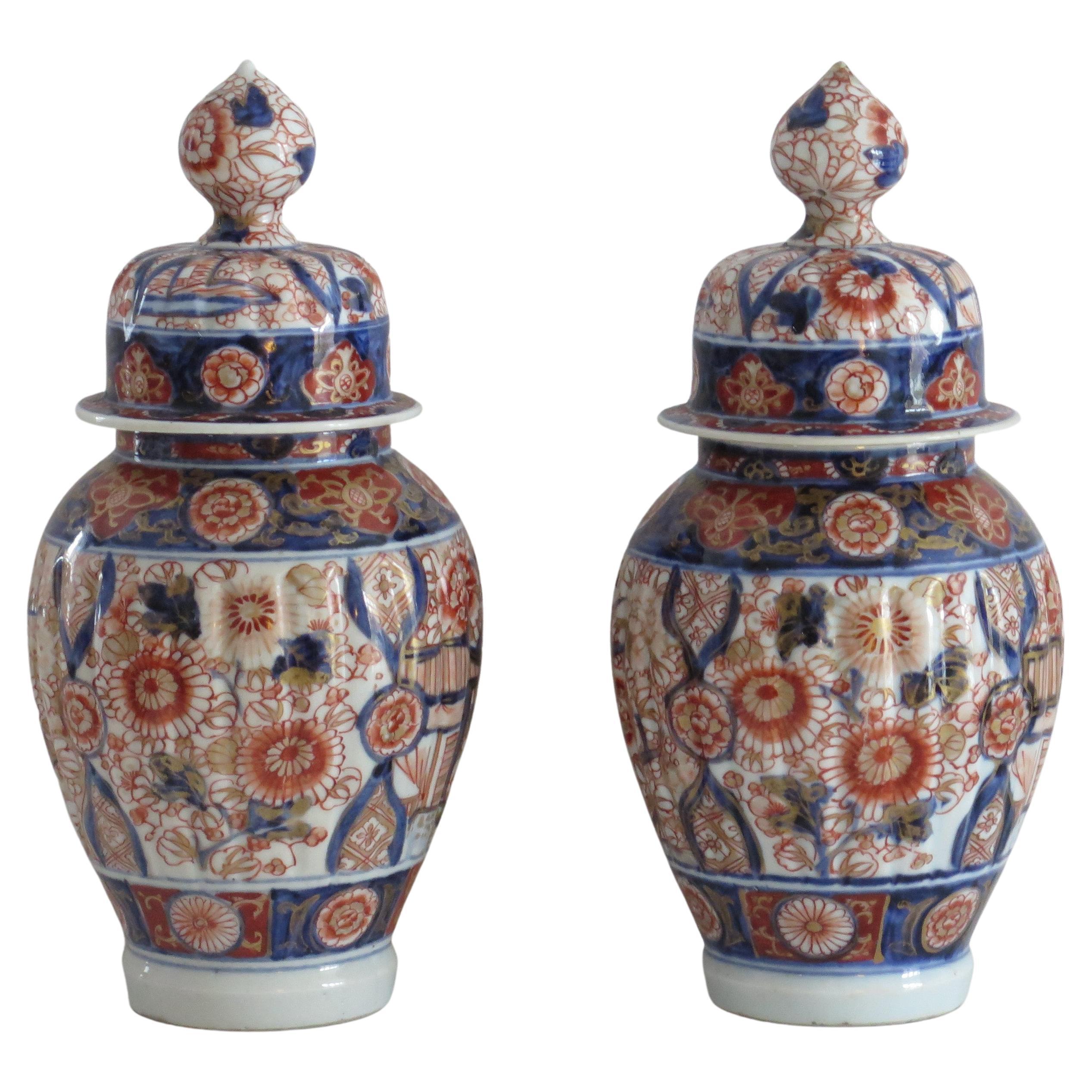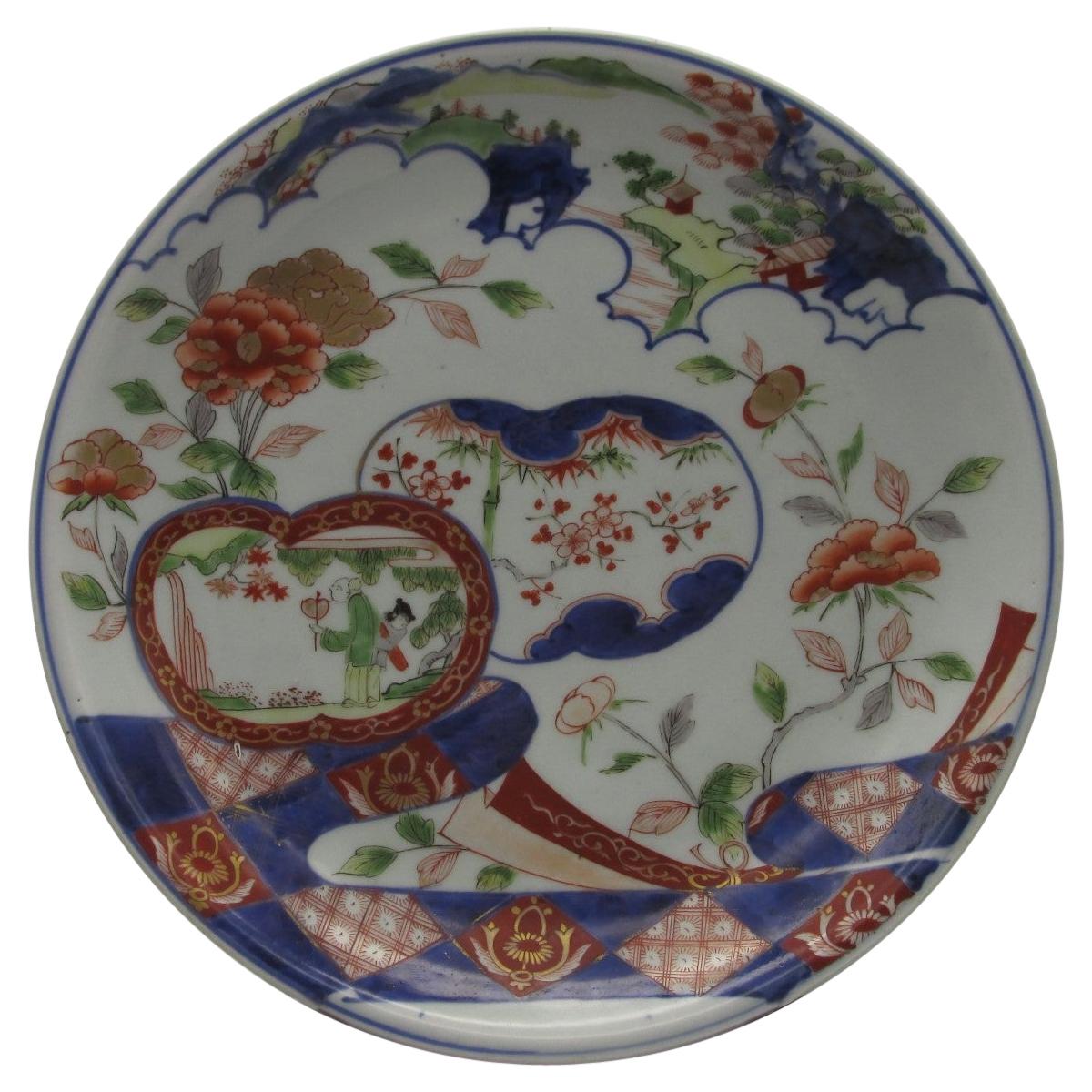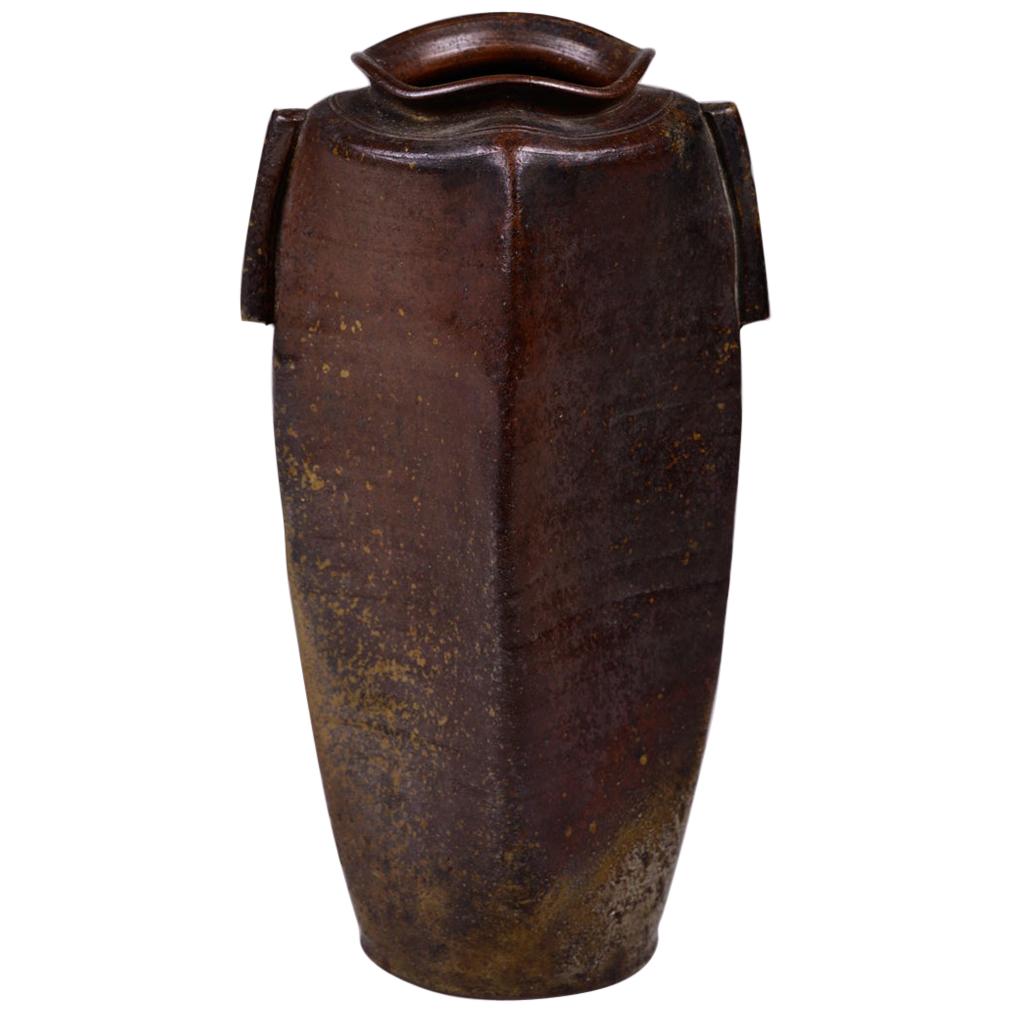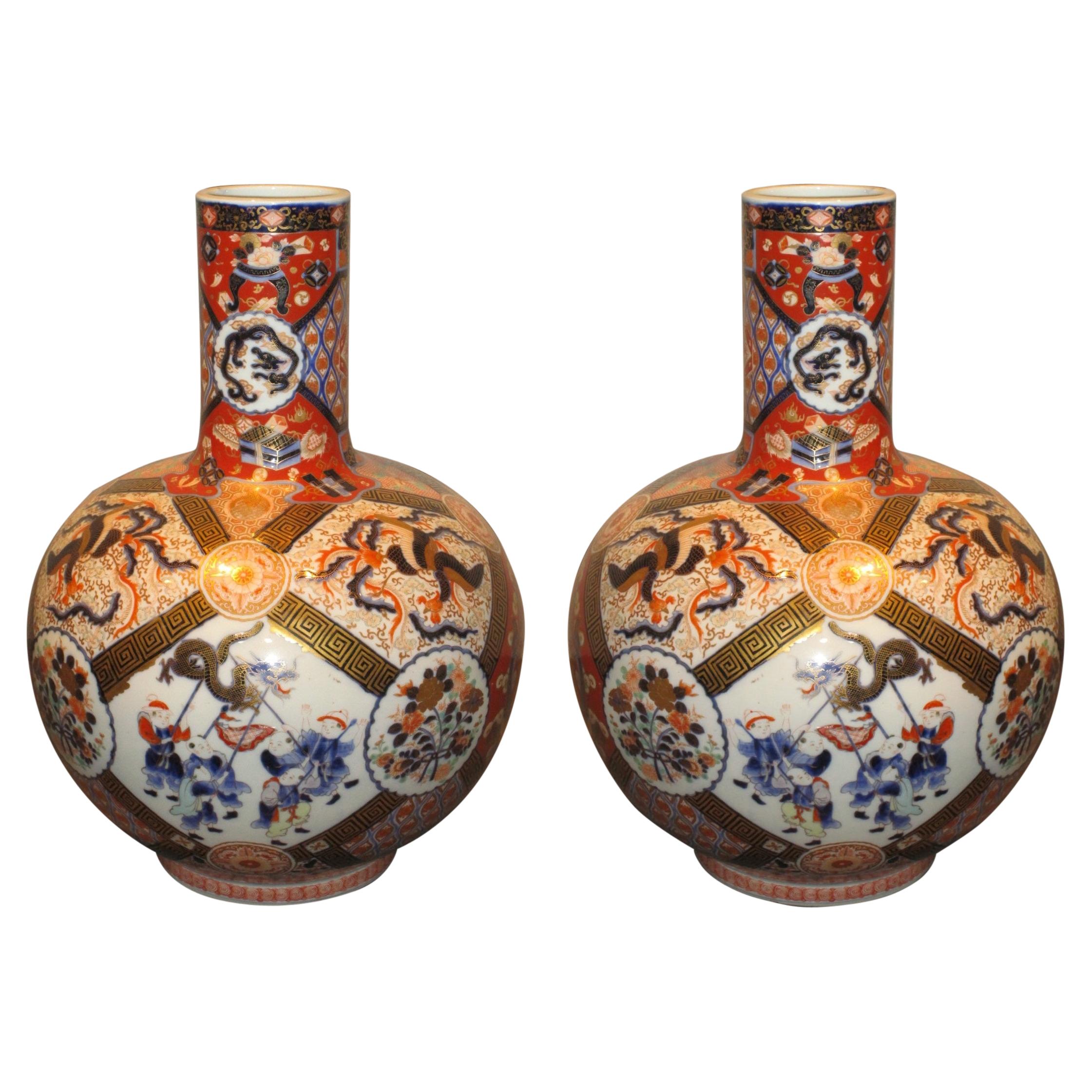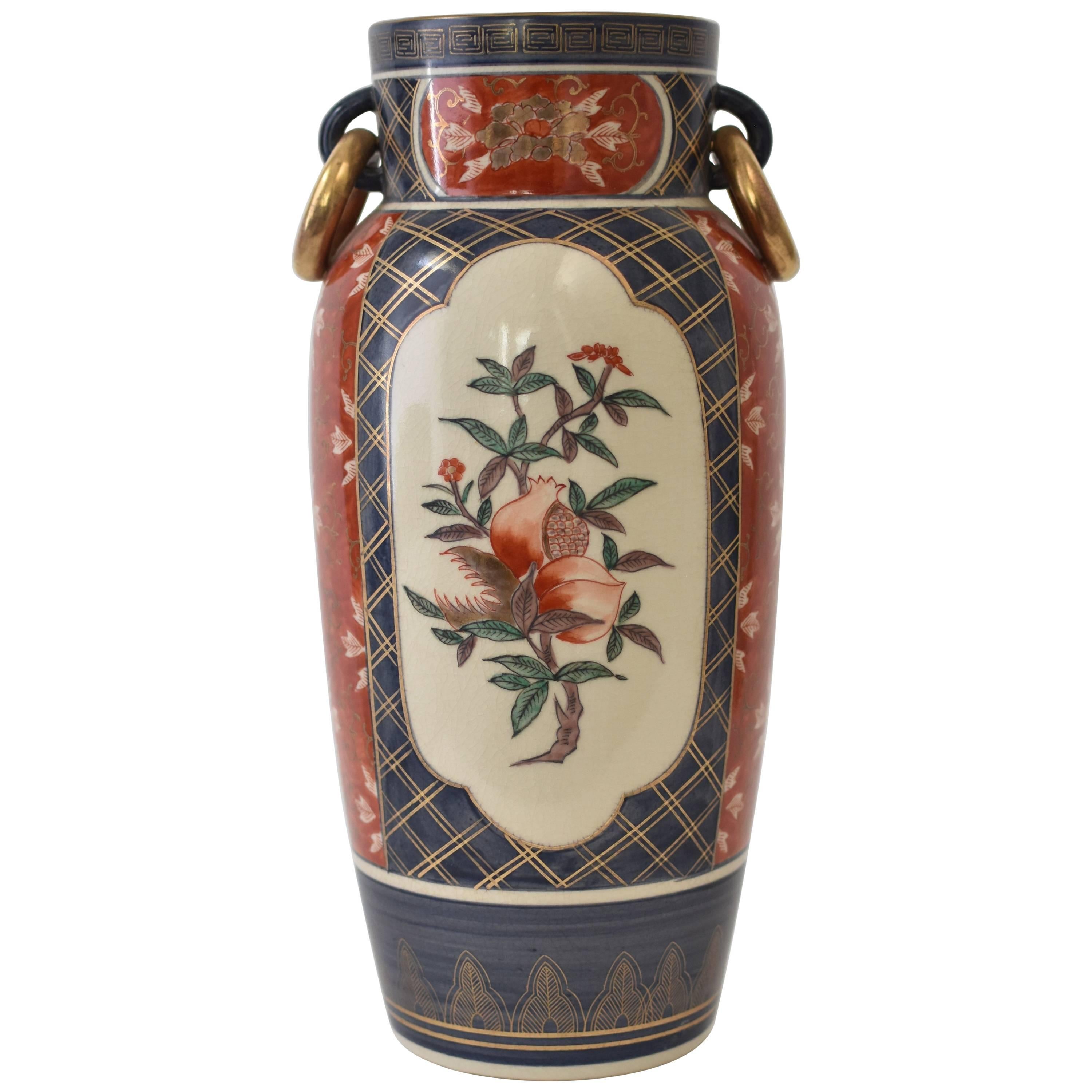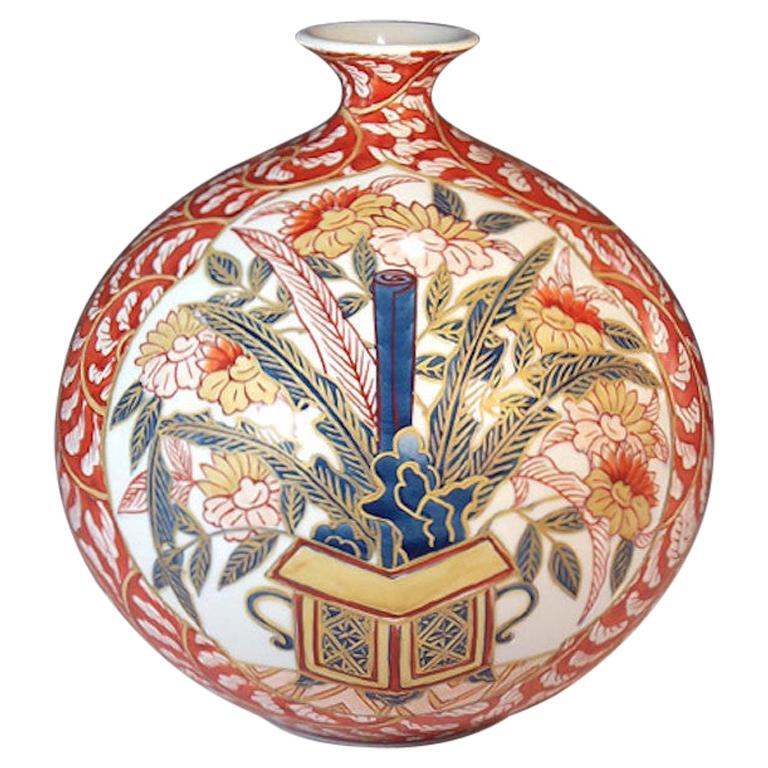Items Similar to Pair of Edo Period Japanese Blue Red Gold Porcelain Vases, Circa 1800
Want more images or videos?
Request additional images or videos from the seller
1 of 15
Pair of Edo Period Japanese Blue Red Gold Porcelain Vases, Circa 1800
About the Item
Exquisite pair of mid Edo period large Japanese Ko-Imari porcelain vases in an attractive baluster shape boasting intricate patterns of floral and highly detailed geometric motifs that beautifully intertwine on the body of the handsome vases, creating captivating landscapes in dark blue, orange and gold details throughout, which is characteristic of Imari porcelain from the Edo Period.
The two scalloped cartouches on each vase with highly decorated and elaborate borders recreate the pine, plum and bamboo motif known as “Sho-Chiku-Bai” or the “Three Friends of Winter.”
The impressive pine trees in cobalt blue decorated with gold details dominate the landscape on white background. The two small delicately scalloped cartouches appearing in the middle of the long neck of the vases depict playful rabbits among trees.
The late father of the collector of this exquisite pair, who operated one of the leading kilns in the historic Imari-Arita region of Japan, travelled extensively to Europe in the early 1960s with a mission that he led, to purchase and bring back to Japan antique ceramics that had been exported from Japan to the west over the past 250 years. A total of 104 pieces were acquired and brought back. These were very unique pieces, designed and produced to export to Europe and later to America too, mostly in the 18th up to very early 20th century. These were carefully studied and extensively copied in the hope of creating products that conformed with the long-standing tastes and preferences in the west and bringing back the glory of that era. He concentrated on purchasing massive masterpieces that originated from his region of Imari-Arita. Records show that the mission did a considerable portion of its buying in London. All the 104 pieces have been in his museum quality private collection. This pair of Meiji porcelain vases is among these 104 exceptional and unique pieces.
Dimensions: H 30 in D 14 in
- Dimensions:Height: 30 in (76.2 cm)Diameter: 14 in (35.56 cm)
- Sold As:Set of 2
- Style:Edo (Of the Period)
- Materials and Techniques:
- Place of Origin:
- Period:
- Date of Manufacture:circa 1800
- Condition:Wear consistent with age and use. This pair is in excellent condition. There are no cracks or chips.
- Seller Location:Takarazuka, JP
- Reference Number:1stDibs: LU277137916363
About the Seller
5.0
Gold Seller
These expertly vetted sellers are highly rated and consistently exceed customer expectations.
Established in 2009
1stDibs seller since 2017
211 sales on 1stDibs
Typical response time: 1 hour
- ShippingRetrieving quote...Ships From: Takarazuka, Japan
- Return PolicyA return for this item may be initiated within 7 days of delivery.
More From This SellerView All
- Japanese Edo Period Blue Red Green Porcelain Charger, circa 1730Located in Takarazuka, JPExquisite mid-18th century Japanese porcelain charger, first half of Edo period (1603-1868). It depicts the traditional "sho-chiku-bai" or "Three Friend's of Winter" motif in cobalt ...Category
Antique 1730s Japanese Edo Decorative Dishes and Vide-Poche
MaterialsGold
- Pair of Japanese Late Meiji Period Fukagawa Porcelain Vases, circa 1900Located in Takarazuka, JPSuperb pair of Japanese large Meiji period Fukagawa signed porcelain vases (circa 1900). Intricately hand-painted in cobalt blue underglaze with polychrome and gold overglaze on a st...Category
Antique Early 1900s Japanese Meiji Vases
MaterialsGold
- Japanese Contemporary Red Blue Green Gold Porcelain Vase, 6Located in Takarazuka, JPJapanese contemporary porcelain vase featuring gilded ring handles presents traditional Imari floral motifs against a fine crackle-glaze background on a beautifully shaped porcelain body. Bordered in blue and set off by a simple geometric design rendered in gold, the two scalloped panels depict peaches and pomegranates in shades of orange surrounded by green and brown foliage against a soft cream background. The pomegranates have burst open to reveal their ripened seeds. The two panels are connected by a traditional floral motif with golden peonies...Category
21st Century and Contemporary Japanese Meiji Vases
MaterialsGold
- Japanese Contemporary White Red Blue Porcelain Vase by Master Artist, 5Located in Takarazuka, JPElegant contemporary Japanese porcelain decorative vase, beautifully hand painted in red, white and blue on a strikingly shaped body, ...Category
21st Century and Contemporary Japanese Edo Vases
MaterialsGold
- Japanese Blue Purple Porcelain Vase, circa 1935Located in Takarazuka, JPJapanese mid 20th century signed decorative porcelain vase (circa 1935,) from Showa period (1926 to 1985). It depicts an attractive safflower motif, an elegant scene hand-painted in purple and underglaze blue on a pure white background, on a beautifully shaped porcelain body. The artist's signature appears at the reverse side of the vase. This exquisite vase is in excellent condition. The late father of the collector of this exquisite pair, who operated one of the leading kilns in Imari-Arita region of Japan, travelled extensively to Europe in the early 1960s with a mission that he led, to purchase and bring back to Japan antique ceramics...Category
21st Century and Contemporary Asian Meiji Vases
MaterialsPorcelain
- Japanese Green Gold Blue Porcelain Vase by Contemporary Master ArtistLocated in Takarazuka, JPExceptional contemporary Japanese porcelain vase, a masterpiece from the artist's exclusive signature collection, extremely intricately hand painted in blue, green, black and gold by...Category
21st Century and Contemporary Japanese Edo Vases
MaterialsPorcelain
You May Also Like
- Pair Japanese Porcelain Lidded Vases Imari Hand Painted, Edo Period circa 1830Located in Lincoln, LincolnshireThese are a high quality pair of very decorative gilded hand enameled Japanese porcelain lidded vases which we date to the Edo period of the 19th century, circa 1830. Each vase has a baluster open necked shape and has been hand painted in an Imari design with varying shades of under-glaze cobalt blue, with over-glaze burnt orange, salmon and grey enamels. The decoration alternates around the central section with many flowers, buildings, fences and other motifs. The quality of the painting is high and there are border designs around the vases and the lids. There are no marks to the base. Overall a very beautiful pair of Japanese vases. Notes: Imari porcelain is the name given to Japanese export porcelain...Category
Antique Early 19th Century Japanese Edo Ceramics
MaterialsPorcelain
- Edo Period Bizen VaseLocated in Hudson, NYEdo period Bizen vase, late Edo period (mid-19th century) ceramic vase from Bizen, one of the six ancient kilns in Japan. Unusual undulating rim, with tradi...Category
Antique Mid-19th Century Japanese Edo Ceramics
MaterialsCeramic
- Pair of antique Japanese porcelain vasesLocated in London, GBPair of antique Japanese porcelain vases Japanese, early 20th Century Height 86.5cm, diameter 36cm The beautiful Imari porcelain vases...Category
Early 20th Century Japanese Vases
MaterialsPorcelain
- Japanese Porcelain Vase Meiji Period Makuzu KozanBy Makuzu KozanLocated in Atlanta, GAA finely decorated and glazed Japanese porcelain vase by Makuzu Kozan (1842-1916) circa 1900s Meiji Period. The vase is of a classic bottle form with baluster body and short neck. It was decorated with underglaze white magnolia blossom on a pleasant celadon background. The stamens of the flower were artistically rendered in a low relief, giving the design a realistic appeal with the dimension. Miyagawa Kozan...Category
Early 20th Century Japanese Meiji Ceramics
MaterialsPorcelain
- Japanese Porcelain Vase Makuzu Kozan Meiji PeriodBy Makuzu KozanLocated in Atlanta, GAA striking blue and white vase from the studio of Japanese Potter Makuzu Kozan, also known as Miyagawa Kozan (1842–1916), one of the most established and collected ceramist from Meiji Period. Born as Miyagawa Toranosuke, Kozan established his pottery studio in Yokohama circa 1870s and later became one of the appointed artists to the Japanese Imperial household. His work was exhibited in many international fairs that the Meiji government participated at the turn of the century and won many grand prizes. Of a relatively large size, this vase is decorated with underglaze cobalt blue using the novel technique developed by Kozan called Fuki-e (the blow painting). As a result, the bamboos appear took on a three-dimensional quality as if appearing in a mist. Known as one of the most creative ceramists, circa 1887, Kozan started experimenting with new chemical colors from the West in the format of his porcelain glaze. New colors allowed him to create underglaze design that appeared bright, smooth and glossy. He even invented his own receipt of cobalt blue to achieve a much brighter yet softer shade, as evident on this vase. To create landscape that is realistic and dimensional, more common in the western paintings, he was inspired by the native Japanese ink painting technique developed around 1900 by Yokoyama Taikan...Category
Antique Early 1900s Japanese Japonisme Ceramics
MaterialsCeramic
- Late 17th Century Edo Period Japanese Ko-Kutani Porcelain Tokkuri, Sake BottleLocated in Miami, FLKo-Kutani Tokkuri (sake bottle) Edo period (1615-1868), late 17th century Decorated in colored enamels, the lower section painted with scattered medallions of unidentified charac...Category
Antique Late 17th Century Japanese Vases
MaterialsPorcelain
Recently Viewed
View AllMore Ways To Browse
1800 Gold
1800 Antique Bedroom Furniture
Antique Red White Blue
American 1800
18th Century Red And Gold
19th Century American Vases
Hall Tree Gold
Blue And White European Porcelain
Japan Blue Cobalt
Pair Of Early 18th Century Blue
Red Antique Landscape
Cobalt Blue Gold White
Edo Period Gold
Antique American Blue Painted Furniture
Blue And White Porcelain Europe
Red Edo
Red And Blue Antique Porcelain
Early American Furniture 1800
